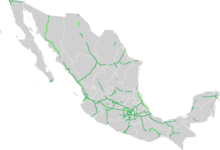This article needs additional citations for
verification. (January 2018) |
This article may require
cleanup to meet Wikipedia's
quality standards. The specific problem is: Ungrammatical, unclear punctuation. (November 2021) |
| Federal Highways | |
|---|---|




 One-, two-, three-digit, and letter designation shields and tollway shield | |
 | |
| System information | |
| Maintained by Secretariat of Communications and Transportation | |
| Highway names | |
| Federal Highway: | Federal Highway X (Fed. X) |
| System links | |
Federal Highways ( Spanish: Carreteras Federales) are a series of highways in Mexico. These highways link the nation's 32 federal entities with each other or with a neighboring country, and they are wholly or mostly built by Mexico's federal government with federal funds or through federal grants by individuals, states, or municipalities. [1] Locally known as federal highway corridors ( Spanish: los corredores carreteros federales), they are built and maintained by Mexico's Secretariat of Communications and Transportation (Spanish: Secretaría de Comunicaciones y Transportes, SCT). Federal Highways in Mexico can be classified into high-speed, limited access expressways (usually toll highways that may be segmented and are marked by the letter "D") and low-speed roads with non-limited access; not all corridors are completely improved.
High speed, limited-access expressways
High-speed expressways, known as autopistas or carreteras de cobro, are limited-access toll roads with controlled interchanges. Access to these roads is generally prohibited for pedestrians and animal-drawn vehicles, and fences are located at the side of the road for most of the length. Autopistas are highways with four or more defined lanes. Supercarreteras are toll roads with only two lanes, and they are most commonly found in mountainous areas. These tolled expressways typically have a corresponding non-limited-access road adjacent to them as a free alternative. In this system, the tolled road is signified by the word Cuota (toll), and the free road by the word Libre (free). The maximum speed limit is normally 110 km/h (68 mph) for cars and 95 km/h (59 mph) for buses and trucks. In some cases, the maximum speed can be 120 km/h (75 mph). [2]
Low speed, non-limited-access roads
Low-speed roads, known as carreteras, comprise the majority of the roads in this system. Some of these roads are divided highways with four or more lanes, often single-carriageway roads which have been converted into dual carriageways by building an adjacent carriageway next to the existing one. These roads are free of charge, and in most cases, two-lane highways that connect almost all of Mexico. These roads have interchanges at major roads, but most of these intersections are at grade. The maximum speed limit is 100 km/h (62 mph) for cars and 95 km/h (59 mph) for buses and trucks. [2]
Numbering system
North–south highways are assigned odd numbers, while east-west highways are identified by even numbers. The start of the numbering system is located in the northwest of the country.
Exceptions to the numbering system
There are two exceptions to the numbering system:[ citation needed]
- Federal Highway 14 (Fed. 14) and Federal Highway 14D (Fed. 14D) from Uruapan, Michoacán, to Morelia, Michoacán, located in the midwest of the country.
- Several roads with letter designations: the Autopista Arco Norte (M40D), Fed. I-20D (Libramiento de Irapuato), Fed. S30 (Libramiento Norponiente de Saltillo, signed as 40D) and, Fed. GUA 10D (Macrolibramiento Sur De Guadalajara).
Incidents
See also
References
- ^ Gutiérrez, Norma (March 2014). "National Funding of Road Infrastructure: Mexico". www.loc.gov. Retrieved 21 February 2020.
- ^ a b "Driving in Mexico | Tips | Mexpro". www.mexpro.com. Retrieved 2018-01-12.